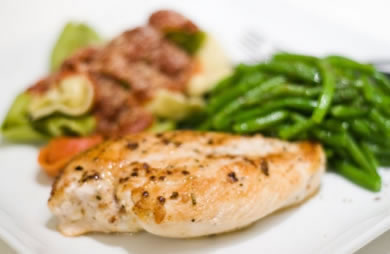|
My culinary training is rooted in the classics of French cooking. The recipes, mother sauces, and techniques have been the same for generations--even centuries, in some cases. But plenty of things change in the kitchen all the time: ingredients, tools, and recently, even safe cooking temperatures. In the classroom, at restaurants, and in public settings, chefs will follow the rules of food safety, but sometimes that can be at odds with taste, which takes center stage. That's why you see those warnings at the bottom of menus: "WARNING: Consuming raw or undercooked meat, poultry, seafood, shellfish and eggs may increase your risk of food borne illness, especially if you have a medical condition." Over-easy eggs, rare steak and oysters on the half shell sure are tasty, but there is a chance that they can make you ill, so we chefs have to warn you of that. For years, chefs (including myself) have recommended serving pork that was still a little pink for the best taste. (And the U.S. FDA, which regulates restaurants, has allowed a lower cooking temperature for pork and other meats.) However, the USDA, the government agency that sets food safety guidelines, recommended cooking the pork until it was 160 degrees Fahrenheit inside, which meant a well-done (and bone-dry) piece of pork. The good news is that the USDA recently changed the rules: Pork lowered the recommended temperature by 15 degrees! Pork should now be cooked to an internal temperature of 145 degrees Fahrenheit, then allowed to rest for three minutes before serving. This means your pork might still be a bit pink in the middle but safe to eat. Allowing the meat to rest is important for two reasons: The meat's temperature will either stay the same or rise during that time, killing any micro-organisms that might make you ill, and it will allow the meat's juices to redistribute. (You should allow all meat to rest for a few minutes before serving to prevent all those delicious juices from leaking out when you make your first cut!) This rule applies only to all whole cuts of meat (both beef and pork): chops, tenderloins, steaks, and roasts. It does not apply to ground meats, which should be cooked to 160 degrees Fahrenheit. (Chicken and turkey, whether ground or whole, should always be cooked to 165 degrees Fahrenheit. Never serve pink chicken!) Why the change? Pork today is leaner than ever--up to 30% leaner according to the USDA--due to changes in breeding and feeding. In the past, pork needed to be cooked until well done because of the fear of parasites, particularly trichinosis. That illness is not an issue these days, but we still need to practice safe handling practices any time we handle raw meats. Helpful Dos and Don'ts
Read Tanya's blog for more food safety tips! Pork Recipes:
Want more great recipes from me and fellow SparkPeople members? Be sure to subscribe to SparkPeople's Recipe of the Day email. Click here to sign up! Will you continue to cook your pork until it's well done, or will you serve it a bit pink? |
|














.jpg)
